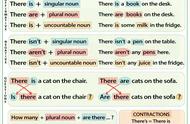新概念英语第一册语法总结 ---句型和词
一. 特殊句型:there be 句型,Be going to 结构
1. Be going to 结构
表示打算,准备,计划做某事
★结构:主语 be动词 going to 动词原型
I am going to make a bookcase.
They are going to paint it.
The father is going to give the bookcase to his daughter.
★变疑问句将be动词移到句首
Are you going to make a bookcase?
Are they going to paint it?
Is the father going to give the bookcase to his daughter?
★变否定句在be动词后面加not
I am not going to make a bookcase.
They are going to paint it.
My father is not going to read newspapers.
★肯定回答及否定回答
Yes, I am. No, I am not.
Yes, they are. No, they are not.
Yes, he is. No, he is not.
★特殊疑问句(对划线部分提问)
What are you going to do?
What are they going to do?
What is your father going to do?
2. There be 句型
表示哪里有什么东西(某处有某物)
There is+单数名词+表示场所的词(一般为介词词组)
There is a book in this room.
There is a pen on the table
There are+复数名词+表示场所的词(一般为介词词组)
There are two pens on the table.
There are three schools there.
★变疑问句将be动词移到句首
Is there a book in this room?
Are there two pens on the table?
★变否定句在动词后面加not
There is not a book in this room.
There are not two pens on the table.
★肯定回答及否定回答
Yes, there is. No, there is not.
Yes, there are. No, there are not.
三.问句:
一般疑问句,特殊疑问句,选择疑问句,反意疑问句,选择疑问句,否定疑问句
一般疑问句: 助动词/be动词 主语
Are you a teacher? Do you want to have a cup of tea?
特殊疑问句: 特殊疑问词 一般疑问句
What is your name?
选择疑问句: or
Do you want beef or lamb?
反意疑问句: 肯定陈述句 否定疑问部分,否定陈述部分 肯定疑问部分 (前肯后否,前否后肯)
You don’t need that pen, do you?
否定疑问句: 一般疑问句 否定词
Aren’t you lucky? Don’t you want have a rest?
四.冠词用法:a/an/the的一般用法( 详细见笔记)
五.限定词:some, any, many, much
some, any 修饰可数名词或不可数名词,some用于肯定句,any用于否定句和疑问句,注意,当期待对方的答案为肯定回答时用some
many修饰可数名词,much修饰不可数名词,在口语中表示很多一般不用many, much, 而用a lot of, 在否定句中表示很多用many, much.
I have a lot of money. I don’t have much money.
六.名词:种类,复数,名词所有格
1.名词分为可数名词和不可数名词
不可数名词
无法分开的东西:water, tea, bread, milk, rice(米)
抽象的东西:love, knowledge
不可数名词有以下特点:
l. 不能用a, an修饰
2. 不能加s
3.和单数be动词或动词搭配
²可数名词:(可数名词单数不可以单独使用, 可用冠词,形容词性物主代词修饰,可数名词复数要在名词后面加s)
可数名词单数变复数的规则变化
1) 一般情况直接在词尾加-s . 如:chair—chairs;apple—apples;grape—grapes;desk—desks等。
2)以s、sh、ch、x等结尾的词加–es .如:bus—buses;watch—watches;box—boxes;brush—brushes等。
3)以辅音字母 y结尾的词,变y 为i 再加es,baby—babies;city—cities;family—families等。
以元音字母 y结尾的词,直接加s. boy—boys, monkey—monkeys等
4)以f或fe结尾的单词,去掉f或fe,再加ves. 如:knife—knives;thief—thieves;shelf—shelves等。
2、不规则变化
1)没有规律的变化。如:child—children;foot—feet;tooth—teeth;mouse—mice;woman—women等。
2)单复同形。如:deer—deer;sheep—sheep;fish—fish
3)以o结尾的名词有的加es有的加s. 如:potato—potatoes;tomato—tomatoes;hero—heroes等。
七.介词: 时间介词at,on,in的用法
- at 用在具体的时刻和中午,夜晚前面。
如:at 6:00, at half past four , at noon, at night
- on用在具体星期、日期前面。
如:on Monday, on September 1st , on a cold morning
3、in 用在年、月、季节或早上、下午、晚上前面。如:
in 2008, in February, in spring, in the morning,in the afternoon
注意英语里的时间排序与中文不同,要由小到大的顺序表达:
at two o’clock in the afternoon 在下午2点
on September 1st ,2021 2021年9月1日。
八.副词:用法及形容词变副词的变化
副词可以修饰形容词,动词,副词或整个句子。如:
The book is very good.
He runs fast.
She came here quite early.
Certainly I will go with you.
变化:
1.直接在形容词后加-ly,
careful-carefully, slow-slowly,
2.以辅音字母加y结尾的形容词,把y变I, 加-ly,
happy-happily, lucky-luckily
3.有些词形容词和副词的形式相同,不需要做任何变化
fast, hard, late
4.有些词加上-ly后意思与原词相差很远:
near-nearly, late-lately,
九.情态动词的使用:can, must, may, might, need,
1.情态动词can(能够), must(必须), may(可以)
结构:主语 can/must/may 动词原型
He can make the tea.
We can speak English.
★变疑问句将情态动词移到句首
Can he make the tea?
Can we speak English?
★变否定句在情态动词后面加not can not = can’t
He cannot make the tea.
We can not speak English.
★肯定回答及否定回答
Yes, he can. No, he can’t.
Yes, we can. No, we can’t.
★特殊疑问句:
What can you do?
注意:情态动词的句子没有第三人称单数的变化
2.must/have to的区别
must 表示必须,是主观上觉得应该做,have to是不得不,是由于客观条件逼迫的必要要做
must 只能用在表示现在和将来的句子里,而have to do可以用在任何时态
3.must, may, might表示猜测:
must do 表示对现在事实的猜测
must have done表示对过去事实的猜测
must have been doing 表示对过去正在进行的事实的猜测
may/might do, may/might have done表示没有任何事实依据的猜测,might的可能性更小。
can’t/couldn’t 表示不可能
4.need 用法:
表示“需要”时为实意动词,后面可以加名词,也可以加不定式:
I need a pen. Do you need any beer? No, I don’t.
I need to have a rest.
need doing=need to be done,表示被动
The flowers need watering.
Need在否定时做情态动词使用
You needn’t go so early. =You don’t need to go so early.
Must I clean the desk right now? No, you needn’t.
十.不定代词及不定副词:
形容词修饰不定代词要后置 something important
some | any | no | every | |
thing | something | anything | nothing | everything |
one | someone | anyone | anything | everyone |
where | somewhere | anywhere | anywhere | everywhere |
body | somebody | anybody | nobody | everybody |
I looked for my book everywhere, but I can’t find it anywhere.
Everybody is here, Let’s begin our class.
Where did you go? I went nowhere.
Nobody is at home.
I have nothing left.
,










